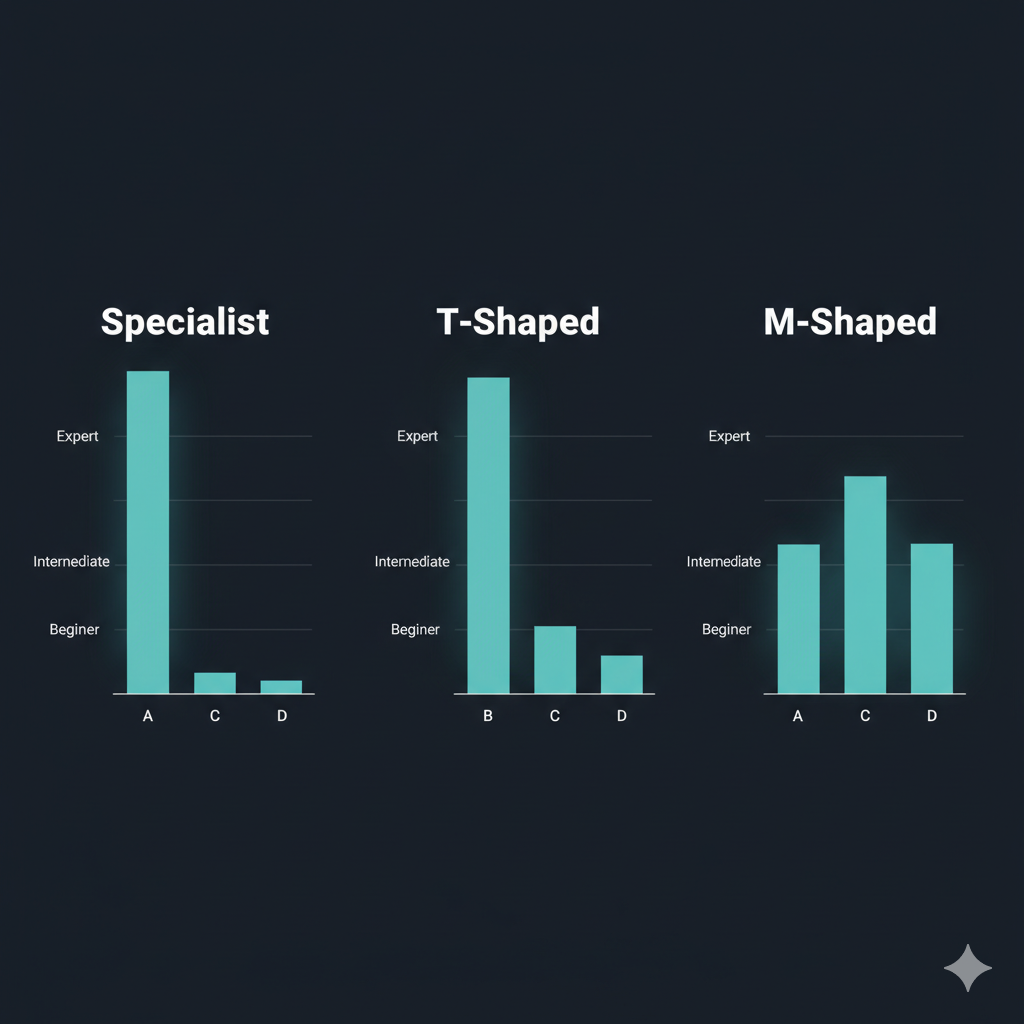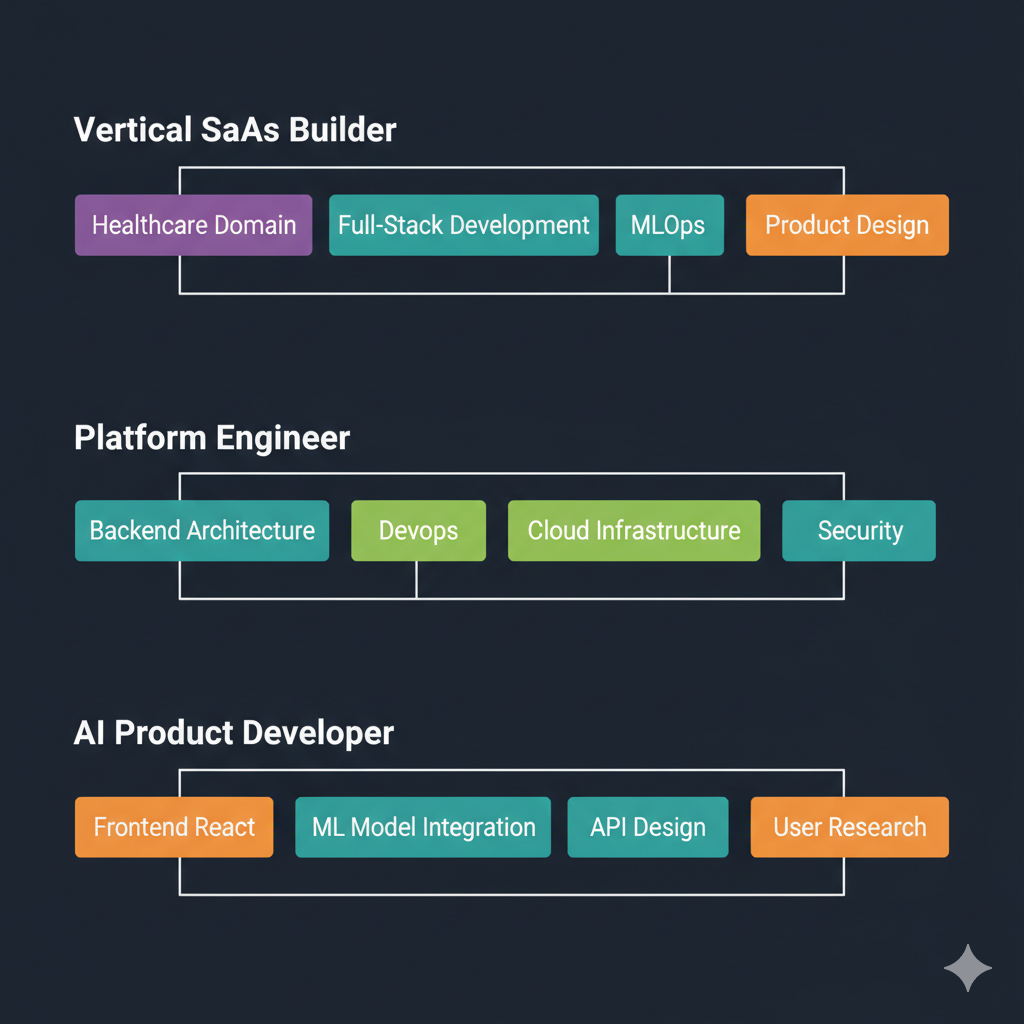The M-Shaped Developer—What AIDD Makes Possible
Lesson Video:
You've just learned about nine foundational pillars that define AI-Driven Development. But here's the transformation they unlock: the M-Shaped Developer—a professional who maintains deep expertise across multiple complementary domains, something that was practically impossible before AI augmentation.
Beyond T-Shaped: Understanding M-Shaped
For years, the career development ideal was the "T-shaped developer": deep expertise in one area with broad, shallow knowledge across others. A backend specialist who could read frontend code. A frontend expert who understood deployment basics.
The M-Shaped Developer is different. Instead of one deep expertise peak, you develop multiple peaks—deep, production-level mastery across several complementary domains. On a skill graph, this creates an "M" shape: multiple areas of true expertise, not just surface familiarity.

Here's the distinction:
| Profile Type | Skill Depth | Number of Domains | Traditional Team Size | AIDD Enabled? |
|---|---|---|---|---|
| Specialist | Very Deep | 1 domain | 1 person per domain | No (always valuable) |
| T-Shaped | Deep in 1, Shallow in others | 1 deep + broad basics | 1 person + consultants | Partially |
| Generalist | Shallow | Many domains | Needs specialists for depth | No |
| M-Shaped | Deep in multiple | 2-4 complementary domains | Previously needed multiple specialists | Yes |
The M-Shaped developer isn't a generalist with surface knowledge. They're someone who can:
- Design a complex API architecture (backend expertise)
- Implement the frontend with production-grade patterns (frontend expertise)
- Deploy it to cloud infrastructure with proper monitoring (DevOps expertise)
- Integrate ML models with appropriate safeguards (AI/ML expertise)
All at a professional level. All in the same week. Often in the same day.
Why Now? The Nine Pillars as Enablers
Traditional development required separate specialists because mastering multiple domains was cognitively overwhelming. You couldn't be an expert backend developer AND an expert DevOps engineer AND an expert frontend architect—there simply weren't enough hours to learn, practice, and maintain mastery across domains.
Each of the nine pillars removes a specific barrier:
-
AI CLI & Coding Agents — Get expert-level assistance in domains outside your primary expertise. Need to write a complex Kubernetes config? The agent provides production patterns you'd otherwise spend weeks learning.
-
Markdown as Programming Language — Access domain knowledge on demand through natural language specifications. Write what you want; AI translates to implementation.
-
MCP Standard — Universal tool integration means you don't need to master every tool's API. AI agents handle the integration complexity.
-
AI-First IDEs — Reduce cognitive load across all domains. Context-aware suggestions work whether you're writing Python, TypeScript, or Terraform.
-
Linux Universal Dev Env — One environment, all platforms. Master the Linux CLI once; use it everywhere from local development to cloud deployment.
-
Test-Driven Development — Maintain correctness across domains without memorizing every API. Type hints and tests catch errors even in unfamiliar territory.
-
Specification-Driven Development — Maintain quality and clarity across all domains with a structured methodology. SDD helps you avoid cutting corners when working outside your comfort zone.
-
Composable Vertical Skills — Leverage pre-built domain expertise. Install a skill module instead of becoming an expert in that subdomain.
-
Universal Cloud Deployment — One-click deployment removes the "operations specialist" bottleneck. Frontend developers can now ship production infrastructure.
The key insight: These pillars work together. You don't need to memorize every DevOps pattern—you use AI agents (Pillar 1), natural language specs (Pillar 2), and SDD (Pillar 7) to maintain professional-level work even when you're not the domain expert.
Real M-Shaped Profiles in Action

Profile 1: The Vertical SaaS Builder
- Deep Expertise: Healthcare domain knowledge + Full-stack development + MLOps + Product design
- What This Enables: Building a specialized medical scheduling platform with AI-powered patient routing
- Traditional Team: Would require: Domain expert, backend engineer, frontend engineer, ML engineer, product designer (5 people)
- With AIDD: One developer maintains deep expertise across all areas, using AI agents to bridge knowledge gaps and maintain quality
Profile 2: The Platform Engineer
- Deep Expertise: Backend architecture + DevOps + Cloud infrastructure + Security
- What This Enables: Designing, implementing, deploying, and securing a multi-tenant SaaS platform
- Traditional Team: Would require: Backend architect, DevOps engineer, infrastructure specialist, security engineer (4 people)
- With AIDD: One engineer orchestrates the entire platform, using AI for domain-specific best practices and SDD for consistent quality
Profile 3: The AI Product Developer
- Deep Expertise: Frontend (React) + ML model integration + API design + User research
- What This Enables: Building AI-powered user interfaces that integrate ML models with great UX
- Traditional Team: Would require: Frontend engineer, ML engineer, backend engineer, UX researcher (4 people)
- With AIDD: One developer delivers the complete product, using AI agents to maintain expertise across all domains
What's Your M-Shape?
The M-Shaped developer isn't about being good at everything. It's about choosing 2-4 complementary domains where you can maintain deep expertise with AI augmentation.
💬 AI Colearning Prompt
Explore with your AI: "I'm intrigued by the M-shaped developer concept. Help me discover: based on what I already know [describe your background], which TWO domains would pair most naturally as my 'M' shape? Walk me through why these two multiply each other specifically for MY starting point."
Your AI can help you find combinations that leverage your existing strengths.
Pause and Reflect
What would your ideal M-shaped profile look like in 2 years?
Consider combinations like:
- Frontend + Mobile + Design — Build complete user experiences across platforms
- Backend + MLOps + Data Engineering — Build intelligent data-driven systems end-to-end
- Industry Expertise + Full Stack + Product — Build vertical solutions for your domain
- DevOps + Security + Cloud Architecture — Build and secure production infrastructure
- API Design + System Architecture + Developer Experience — Build platforms other developers love
Think about:
- Which domains naturally complement each other in your work?
- Which combinations would make you irreplaceable in your market?
- Which would let you build complete products independently?
- Which align with problems you care about solving?
There's no single right answer. The power of M-shaped development is choosing domains that work together for the products you want to build and the impact you want to have.
Realistic Constraints on M-Shaped Development
M-Shaped development is transformative, but it's not limitless. Understanding the constraints helps you set realistic expectations and choose domains strategically:
Domain Depth Still Matters: AI augmentation accelerates learning and fills knowledge gaps, but it doesn't replace years of specialized experience in critical areas. Security expertise, regulatory compliance, safety-critical systems (medical devices, aviation software), and advanced research domains still require deep, earned expertise that can't be fully AI-generated. An M-shaped developer can build secure authentication flows with AI assistance, but shouldn't architect a financial trading system's security model without genuine depth in that domain.
Domain Compatibility Varies: Some domain combinations naturally reinforce each other—frontend + backend + DevOps creates a cohesive full-stack capability. ML + backend + data engineering builds on similar foundations. But other combinations remain challenging to bridge effectively. Machine learning research + legal compliance, or embedded systems + UX design require fundamentally different mental models that don't easily compound. Choose domains where skills transfer and knowledge reinforces.
Organizational Context Matters: Even if you can span multiple domains effectively, your organization's structure, culture, and risk tolerance shapes how you apply M-shaped capabilities. M-shaped developers thrive in startups and small teams where autonomy is valued and rapid iteration is expected. Large enterprises may still require specialist verification, formal handoffs, and segregation of duties for compliance or risk management. Your capabilities may exceed what your environment allows you to execute independently.
Execution Quality Determines Outcomes: Having M-shaped capabilities creates access and opportunity, not guaranteed success. Market timing, product-market fit, execution quality, and domain-specific insight still determine whether your product succeeds. AIDD removes the barrier of needing a large team—it doesn't remove the need for good judgment, persistence, and continuous learning.
The key insight: M-shaped development dramatically expands what's possible for individuals and small teams. But it's a capability multiplier, not a magic solution. Choose domains strategically, respect the limits of AI augmentation, and recognize that execution and judgment still matter more than ever.
🎓 Expert Insight
The M-shaped developer isn't trying to "know everything"—that's impossible and exhausting. Instead, you're building complementary depth in domains that naturally reinforce each other. Frontend + Backend + DevOps work together because they're sequential steps in one workflow. ML + Data Engineering + Backend combine because they share data pipelines. The "M" emerges from choosing domains that compound, not from arbitrary breadth.
The Urgency Question
Understanding that M-Shaped development is possible is exciting. You can see how AI augmentation enables one person to do what previously required entire teams.
But here's the uncomfortable question: Why is this urgent? Why learn all nine pillars NOW instead of gradually over the next few years?
We'll explore this question in the next lesson.
🤝 Practice Exercise
Ask your AI: "I've identified my ideal M-shape [name your two domains]. Now be brutally honest: what are the three hardest parts of developing depth in both? What would I be signing up for? Don't sugarcoat it."
What you're practicing: Realistic self-assessment through AI partnership. Your AI helps you see the actual path, not the romanticized version.
Try With AI
Use your AI companion tool set up from Chapter 5. If you haven't reached that chapter yet, use ChatGPT web or Claude for this activity.
Prompt 1: Design Your M-Shape Profile
The lesson describes 'M-Shaped' developers with deep expertise in 2-4 complementary domains. Help me design MY ideal M-shape: I'm interested in [list 2-3 areas: frontend / backend / ML / design / DevOps / security / etc.]. Which combination makes the most SENSE for: (a) building complete products alone, (b) becoming irreplaceable in the job market? Create a simple diagram showing my M-shape.
Expected outcome: Personalized M-shape design that makes strategic sense for YOUR goals
Prompt 2: First Steps Roadmap
The lesson shows 3 real M-Shaped profiles (Vertical SaaS Builder, Platform Engineer, AI Product Developer). Pick the one CLOSEST to what I want to become [describe your interest]. Then break down: what are the FIRST 3 skills I should learn (in order)? How long would each take with AI assistance? Be realistic.
Expected outcome: Clear first-steps roadmap for your chosen profile (not generic advice)
Prompt 3: AI Learning Limits Assessment
I'm skeptical about the 'constraints' section. It says AI doesn't replace deep expertise in safety-critical or regulatory domains. Help me understand: For MY chosen M-shape [from prompt 1], which parts can I confidently learn WITH AI, and which parts require traditional deep study? Be honest about the limits.
Expected outcome: Honest assessment of what AI can/can't help you learn
Prompt 4: Two-Year Skill Timeline
The lesson asks 'What would your ideal M-shaped profile look like in 2 years?' Create a visual 'skill acquisition timeline' for me: Month 0-6 (focus on X), Month 7-12 (add Y), Month 13-18 (integrate Z), Month 19-24 (master W). Show how skills compound. Be specific to my chosen domains.
Expected outcome: 2-year timeline showing how skills build progressively